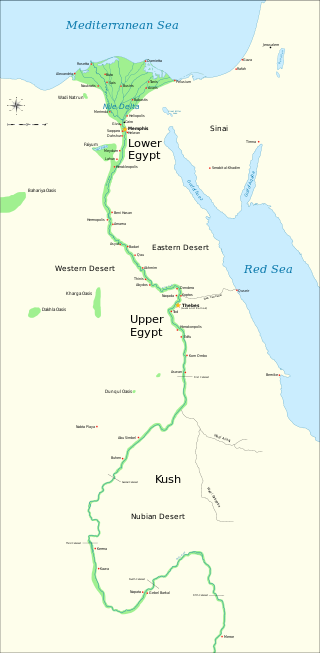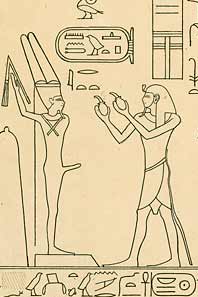
The First Intermediate Period, described as a 'dark period' in ancient Egyptian history, spanned approximately 125 years, c. 2181–2055 BC, after the end of the Old Kingdom. It comprises the Seventh, Eighth, Ninth, Tenth, and part of the Eleventh Dynasties. The concept of a "First Intermediate Period" was coined in 1926 by Egyptologists Georg Steindorff and Henri Frankfort.

The Middle Kingdom of Egypt is the period in the history of ancient Egypt following a period of political division known as the First Intermediate Period. The Middle Kingdom lasted from approximately 2040 to 1782 BC, stretching from the reunification of Egypt under the reign of Mentuhotep II in the Eleventh Dynasty to the end of the Twelfth Dynasty. The kings of the Eleventh Dynasty ruled from Thebes and the kings of the Twelfth Dynasty ruled from el-Lisht.

Deir el-Bahari or Dayr al-Bahri is a complex of mortuary temples and tombs located on the west bank of the Nile, opposite the city of Luxor, Egypt. This is a part of the Theban Necropolis.

The Eleventh Dynasty of ancient Egypt is a well-attested group of rulers. Its earlier members before Pharaoh Mentuhotep II are grouped with the four preceding dynasties to form the First Intermediate Period, whereas the later members are considered part of the Middle Kingdom. They all ruled from Thebes in Upper Egypt.

Hannu, Hennu or Henenu was an Egyptian noble, serving as m-r-pr "majordomo" to Mentuhotep III in the 20th century BC. He reportedly re-opened the trade routes to Punt and Libya for the Middle Kingdom of Egypt. He was buried in a tomb in Deir el-Bahri, in the Theban Necropolis, which has been catalogued as TT313.

Mentuhotep II, also known under his prenomen Nebhepetre, was an ancient Egyptian pharaoh, the sixth ruler of the Eleventh Dynasty. He is credited with reuniting Egypt, thus ending the turbulent First Intermediate Period and becoming the first pharaoh of the Middle Kingdom. He reigned for 51 years, according to the Turin King List. Mentuhotep II succeeded his father Intef III on the throne and was in turn succeeded by his son Mentuhotep III.

Sehertawy Intef I was a local nomarch at Thebes during the early First Intermediate Period and the first member of the 11th Dynasty to lay claim to a Horus name. Intef reigned from 4 to 16 years c. 2120 BC or c. 2070 BC during which time he probably waged war with his northern neighbor, the Coptite nomarch Tjauti. Intef was buried in a saff tomb at El-Tarif, known today as Saff el-Dawaba.
Intef III was the third pharaoh of the Eleventh Dynasty of Egypt during the late First Intermediate Period in the 21st century BC, at a time when Egypt was divided in two kingdoms. The son of his predecessor Intef II and father of his successor Mentuhotep II, Intef III reigned for 8 years over Upper Egypt and extended his domain North against the 10th Dynasty state, perhaps as far north as the 17th nome. He undertook some building activity on Elephantine. Intef III is buried in a large saff tomb at El-Tarif known as Saff el-Barqa.

Sankhkare Mentuhotep III of the Eleventh Dynasty was Pharaoh of Egypt during the Middle Kingdom. He was assigned a reign of 12 years in the Turin Canon.

Amenemhat I, also known as Amenemhet I, was a pharaoh of ancient Egypt and the first king of the Twelfth Dynasty of the Middle Kingdom.

Nebtawyre Mentuhotep IV was the last king of the 11th Dynasty in the Middle Kingdom. He seems to fit into a 7-year period in the Turin Canon for which there is no recorded king.
Lisht or el-Lisht is an Egyptian village located south of Cairo. It is the site of Middle Kingdom royal and elite burials, including two pyramids built by Amenemhat I and Senusret I. The two main pyramids were surrounded by smaller pyramids of members of the royal family, and many mastaba tombs of high officials and their family members. They were constructed throughout the Twelfth and Thirteenth Dynasties. The site is also known for the tomb of Senebtisi, found undisturbed and from which a set of jewelry has been recovered. The pyramid complex of Senusret I is the best preserved from this period. The coffins in the tomb of Sesenebnef present the earliest versions of the Book of the Dead.

Sekhemre Khutawy Amenemhat Sobekhotep was an Egyptian pharaoh of the early 13th Dynasty.
Herbert Eustis Winlock was an American Egyptologist and archaeologist, employed by the Metropolitan Museum of Art for his entire career. Between 1906 and 1931 he took part in excavations at El-Lisht, Kharga Oasis and around Luxor, before serving as director of the Metropolitan Museum from 1932 to 1939.

Tomb TT280, located in Sheikh Abd el-Qurna, part of the Theban Necropolis, is the burial place of the ancient Egyptian noble Meketre who was chancellor and chief steward during the reign of Mentuhotep II and Mentuhotep III, during the Eleventh Dynasty.

Bebi was an Egyptian vizier under king Mentuhotep II in the Eleventh Dynasty. He is known only from a relief fragment found in the mortuary temple of the king at Deir el-Bahari. The fragment is now in the British Museum. The short caption to the figure of Bebi reads: vizier, zab-official, the one belonging to the curtain Bebi. Bebi might have been the first Middle Kingdom official with that title. His successor was Dagi. Perhaps Bebi started his career as treasurer: indeed, a treasurer with the name Bebi is known from the stela of a minor official called Maati, now in the Metropolitan Museum of Art, New York.

The Theban Tomb TT319 is located in Deir el-Bahari, part of the Theban Necropolis, on the west bank of the Nile, opposite to Luxor. The tomb belongs to the king's wife Neferu II, wife of the ancient Egyptian king Mentuhotep II. Neferu was the daughter of Queen Iah and Intef III.

Dagi was an ancient Egyptian vizier during the reign of pharaoh Mentuhotep II of the Eleventh Dynasty.

The Theban Tomb TT385 is located in Sheikh Abd el-Qurna, part of the Theban Necropolis, on the west bank of the Nile, opposite Luxor. It is the burial place of the ancient Egyptian Hunefer (Haunefer), who was a Mayor of the Southern City (Thebes) during the reign of Ramesses II in the Nineteenth Dynasty.
Sobeknakht was an ancient Egyptian official with the main title high steward. He was in office in the Middle Kingdom under king Amenemhat I of the 12th Dynasty, around 1975 BC. Sobeknakht is known from a block with a relief, once adorning the chapel of his tomb at Lisht, close to the pyramid of Amenemhat I. Three other blocks with reliefs were found nearby and belonged once perhaps to the tomb of Sobeknakht too, although they do not mention his name. The tomb itself is not yet located. He is also known from a statue found at Thebes and perhaps from a stela, found at Abydos.


















